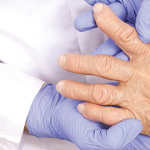“If you tell people they’re at increased risk and why they’re at increased risk, then they’re encouraged to change their behavior to reduce their risk,” Dr. Raza said.
Early Treatment
Even with advances in identifying those at increased risk of moving from an early phase to full-blown RA, these advances can’t be put to use if patients aren’t seen. But the problem of general practitioner referral is a massive one, because so many patients making a visit to a GP report issues with joints. Half of them, for example, report joint stiffness.
National surveys in the United Kingdom have found that only a fraction of GPs will refer a patient to a rheumatologist immediately even if they suspect RA—with many performing initial tests to inform their referral decision, Dr. Raza said.
Online tools meant to sharpen the ability of GPs to more accurately assess the RA risk are being developed, but Dr. Raza cautioned that they are only as good as the algorithms that underlie them. He said he is encouraged by the amount of work being done in this area.
“If you want to diagnose RA early, you have to see patients with RA early. And there are actually quite a lot of initiatives going on.”
Thomas R. Collins is a freelance writer living in South Florida.
References
- Boeters DM, Gaujoux-Viala C, Constantin A, et al. The 2010 ACR/EULAR criteria are not sufficiently accurate in the early identification of autoantibody-negative rheumatoid arthritis: Results from the Leiden-EAC and ESPOIR cohorts. Semin Arthritis Rheum. 2017 Oct;47(2):170–174.
- Boeters DM, Trouw LA, van der Helm-van Mil AHM, et al. Does information on novel identified autoantibodies contribute to predicting the progression from undifferentiated arthritis to rheumatoid arthritis: A study on anti-CarP antibodies as an example. Arthritis Res Ther. 2018 May 3;20(1):94.
- Wang J-R, Gao W-N, Grimm R, et al. A method to identify trace sulfated IgG N-glycans as biomarkers for rheumatoid arthritis. Nature Commun. 2017 Sep 20;8(1):631.
- Sahbudin I, Pickup L, Nightingale P, et al. The role of ultrasound-defined tenosynovitis and synovitis in the prediction of rheumatoid arthritis development. Rheumatology (Oxford). 2018 Apr 3; [Epub ahead of print]
- van Beers-Tas MH, Ter Wee MM, van Tuyl LH, et al. Initial validation and results of the Symptoms in Persons at Risk of Rheumatoid Arthritis (SPARRA) questionnaire: A EULAR project. RMD Open. 2018 May 21;4(1):e000641.
- Ten Brinck RM, van Steenbergen HW, van Delft MAM, et al. The risk of individual autoantibodies, autoantibody combinations and levels for arthritis development in clinically suspect arthralgia. Rheumatology (Oxford). 2017 Dec 1;56(12):2145–2153.
- Gan RW, Bemis EA, Demoruelle MK, et al. The association between omega-3 fatty acid biomarkers and inflammatory arthritis in an anti-citrullinated protein antibody positive population. Rheumatology (Oxford). 2017 Dec 1;56(12):2229–2236.
- Demoruelle MK, Bowers E, Lahey LJ, et al. Antibody responses to citrullinated and noncitrullinated antigens in the sputum of subjects with rheumatoid arthritis and subjects at risk for development of rheumatoid arthritis. Arthritis Rheumatol. 2018 Apr;70(4):516–527.
- Sparks JA, Iversen MD, Yu Z, Triedman NA, et al. Disclosure of personalized rheumatoid arthritis risk using genetics, biomarkers, and lifestyle factors to motivate health behavior improvements: A randomized controlled trial. Arthritis Care Res (Hoboken). 2018 Jun;70(6):823–833.


